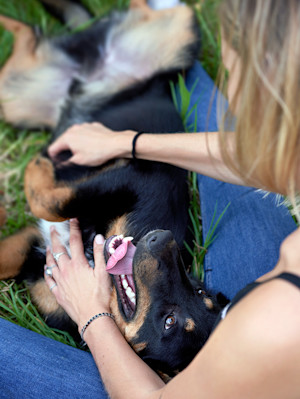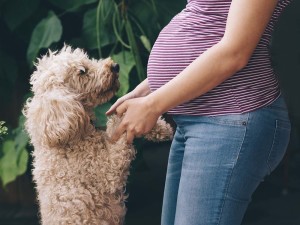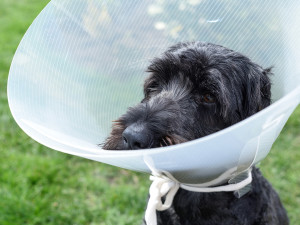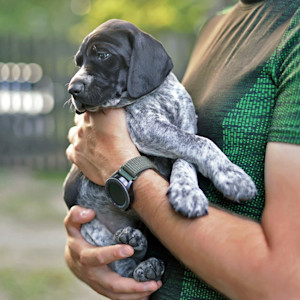What is False Pregnancy (Pseudopregnancy) in Dogs

Share Article
In This Article:
What Is False Pregnancy in Dogs? Signs of False Pregnancy in Dogs Causes of False Pregnancy in Dogs How to Diagnose False Pregnancy Treatment Options for False Pregnancy How to Prevent False Pregnancy in Dogs
Your dog has been babying a previously ignored stuffed toy around the clock. Her mammary glands seem enlarged, and she’s licking them constantly. You take a closer look, and it seems like there’s milk coming out. Hold up, is she pregnant? Maybe she’s had absolutely zero opportunity to mate — so she can’t be pregnant, right?
She’s not pregnant, but her hormones don’t know that. False pregnancy, or pseudopregnancy, can be a confusing experience for dogs and their parents. Here’s what you need to know about false pregnancy in dogs, from signs and causes to treatment and prevention.

What is false pregnancy in dogs?
False pregnancy in dogs is a condition in which a non-pregnant female dog shows physical and behavioral signs of being pregnant or post-partum. The condition goes by many names, including pseudopregnancy, pseudocyesis, phantom pregnancy, and nervous lactation.
Both spayed and intact dogs can develop false pregnancy, though it’s more common in intact females. False pregnancy can affect any breed at any age after puberty.
A dog’s estrous cycle
A dog’s estrous (or heat) cycle has four stages: proestrus, estrus, diestrus, and anestrus. Here’s a super quick review of each one and when false pregnancy happens:
Proestrus: Estrogen helps prepare a dog’s body for mating.
Estrus: Luteinizing hormone (LH) increases and triggers ovulation. A dog is fertile and ready to mate.
Diestrus: False pregnancy occurs during diestrus. Early in diestrus, progesterone increases, even if mating didn’t occur. Progesterone is the hormone that helps the body prepare for pregnancy. Late in diestrus, progesterone decreases, and prolactin increases. Prolactin is the hormone that stimulates many changes associated with pregnancy and nursing. A rapid shift in these hormones can lead to pseudopregnancy.
Anestrus: This is the “rest” period between cycles.
Signs of false pregnancy in dogs
It can be a little alarming when your dog begins to act like she’s pregnant without actually being so. Pseudopregnancy can result in both physical and behavioral changes; some can be quite obvious, while others might take time to notice. Symptoms of false pregnancy in dogs include:
Enlarged mammary glands
Lactation
Discharge from mammary glands
Excessively licking mammary glands
Nesting behavior
“Mothering” inanimate objects (toys or clothing)
Aggressive behavior
Restlessness
Loss of appetite
Weight gain
Abdominal contractions
Lethargy
Causes of false pregnancy in dogs
False pregnancy is often related to hormonal changes in a dog's body, typically occurring after her heat cycle. The condition is thought to be related to a rapid decrease in progesterone and a rise in prolactin.
This fluctuation in hormone levels occurs naturally during a dog’s estrus cycle, usually about two months after she goes into heat. This change can also occur if a dog is spayed during diestrus, the phase of her cycle after going into heat. Note: this is not a reason to not spay your dog.
Though the exact causes of false pregnancy in dogs is not completely understood, there are some risk factors:
Being intact
Previous episodes of false pregnancy
Spaying during diestrus
How to diagnose false pregnancy in dogs
There’s not a single specific test used for the diagnosis of false pregnancy in dogs, so the condition is usually diagnosed using some combination of medical history, physical exam, lab work, and imaging.
If a dog that has no chance of being pregnant displays concerning signs, then false pregnancy is high on the list of possible causes. In these cases, a diagnosis may be made using a medical history and physical exam findings.
If previous mating is possible, a few additional steps are needed to distinguish between a dog’s false pregnancy versus real pregnancy. Imaging like X-rays or ultrasound may be used to search for puppies. Blood work can be used to help support a diagnosis or to rule out other issues. Your vet can also measure relaxin, a hormone produced by the placenta — it would be high in a dog that’s actually pregnant.
It’s important that any dog who is showing signs of pseudopregnancy be seen by their vet. Any changes in a dog’s mammary glands should be evaluated to rule out other issues like mastitis or mammary tumors.
Treatment options for false pregnancy in dogs
Typically, false pregnancy will resolve without treatment within two to three weeks. While false pregnancy often resolves on its own, there are a few ways you can help ease your dog’s symptoms. Natural treatments for false pregnancy in dogs include:
Avoiding mammary stimulation
In normal circumstances, when puppies nurse, they stimulate the release of prolactin, a hormone that stimulates even more milk production. Constant stimulation of the mammary glands can prolong the clinical signs of false pregnancy in dogs, so leaving the mammary glands alone is a must. E-collars and appropriately fitted t-shirts can stop dogs from licking or suckling on their mammary glands. Dog parents should avoid milking the mammary glands or applying cool or warm compresses.
Behavior modification
Maternal behavior should be discouraged by removing any objects that the dog has “adopted.” Minimize the stress of this by replacing their mothering activities with other tasks like food puzzles to serve as a distraction.
Medical intervention may be recommended in cases in which dogs are experiencing symptoms like continuous lactation and severe behavior changes. Medical treatment for false pregnancy in dogs can involve:
Medication
Medications like prolactin inhibitors can lower a dog’s prolactin, the hormone that stimulates lactation and helps maintain pregnancy. This can help reduce a dog’s pseudopregnancy symptoms, but won’t prevent future episodes. Antibiotics may be needed if a dog also develops mastitis at the same time as a false pregnancy.
Surgery
Spay surgery is the best long-term treatment for canine false pregnancy — but the timing matters. A dog should be spayed during anestrus, when hormones are low. Anestrus is the “reset” phase of a dog’s estrous cycle and occurs about three months after a dog goes into heat. Performing spay surgery while a dog is experiencing clinical signs runs the risk of prolonging her symptoms.
How to prevent false pregnancy in dogs
The most effective way to prevent false pregnancy is through spaying your dog. It’s long been thought that the ideal time to spay a puppy is before her first heat cycle, but new research has shown that delaying spaying until a dog is fully mature may help prevent some types of cancer and developmental issues.
Speak to your veterinarian to determine the best time to have her spayed. If a dog is currently experiencing a false pregnancy, the spay should be postponed until after she has recovered.
Bottom line: False pregnancy in dogs
False pregnancy in dogs occurs when a non-pregnant dog exhibits symptoms similar to those of pregnancy or being post-partum, such as nesting, lactation, and maternal behavior. It typically resolves on its own, but in some cases, it may require veterinary intervention. Understanding the signs and knowing when to seek help can make a big difference in your dog's comfort and health.
References
Dockweiler, Jenna, and Aly Cohen. “Dog Estrous Cycles.” Cornell University College of Veterinary Medicine, 31 July 2023, www.vet.cornell.edu/departments-centers-and-institutes/riney-canine-health-center/canine-health-information/dog-estrous-cyclesopens in new tab.
Falceto, Maria Victoria, et al. “Prevalence of Pseudopregnancy in Bitch Attending a Veterinary Teaching Hospital in Spain.” Reproduction in Domestic Animals, vol. 59, no. S3, 1 Oct. 2024, https://doi.org/10.1111/rda.14638opens in new tab. Accessed 7 Feb. 2025.
Root, Amanda L., et al. “Canine Pseudopregnancy: An Evaluation of Prevalence and Current Treatment Protocols in the UK.” BMC Veterinary Research, vol. 14, no. 1, 24 May 2018, bmcvetres.biomedcentral.com/articles/10.1186/s12917-018-1493-1opens in new tab, https://doi.org/10.1186/s12917-018-1493-1opens in new tab.
Singh, L Kipjen, et al. “Canine Pseudopregnancy and Its Treatment Strategies.” JOURNAL of ENTOMOLOGY and ZOOLOGY STUDIES, vol. 6, no. 3, 8 June 2018, www.researchgate.net/publication/325646239_Canine_pseudopregnancy_and_its_treatment_strategiesopens in new tab.
An Update on Pseudopregnancy - WSAVA Congress Proceedings, 2009.

Dr. Alycia Washington, DVM, MS
Alycia Washington is a small-animal emergency veterinarian with over 10 years of experience based in North Carolina. She works as a relief veterinarianopens in new tab and provides services to numerous emergency and specialty hospitals. She also works as a veterinary writer with a focus on educating pet parents.
Related articles
![Pregnant woman and her dog playing in the park.]()
How Dogs React to Pregnant Women
Why pups' behavior may change when you’re expecting.
Is Your Female Dog Humping? Here’s Why It’s Actually Normal
Take these steps to respond to the problem.
![black scruffy dog wearing cone recovering from spay surgery]()
Everything You Need to Know About Spaying and Neutering Your Dog
A vet’s take on why it’s a smart choice. Snip, snip!
Male vs. Female Dogs: Are There Any Real Differences?
World-renowned behaviorist Patricia McConnell explains.
![Cute black and white 5-week-old Greyster puppy being held outdoors in man's hands in summer.]()
A New Study Says Spaying/Neutering Too Early May Health Problems in Certain Dog Breeds
Read on to find out why spaying/neutering is so important, and what the right time is for your pup.
![A woman wearing a knit sweater holding a dog close on the floor of her bedroom.]()
Separation Anxiety in Dogs
Train your dog to stay calm when they’re on their own — instead of sad-singing “All By Myself” until you come home.







